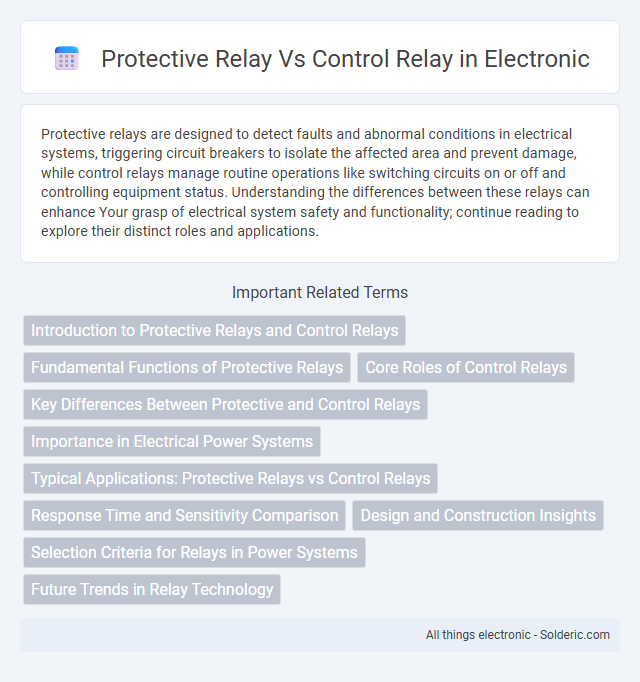Protective relays are designed to detect faults and abnormal conditions in electrical systems, triggering circuit breakers to isolate the affected area and prevent damage, while control relays manage routine operations like switching circuits on or off and controlling equipment status. Understanding the differences between these relays can enhance Your grasp of electrical system safety and functionality; continue reading to explore their distinct roles and applications.
Comparison Table
| Feature | Protective Relay | Control Relay |
|---|---|---|
| Primary Function | Detects faults and protects electrical systems | Controls switching operations and logic functions |
| Application | Power system protection (e.g., circuit breakers) | Automation and control circuits |
| Response Time | Fast, for immediate fault isolation | Moderate, depends on control logic |
| Sensitivity | High sensitivity to abnormal conditions | Standard sensitivity based on control needs |
| Operation | Trip circuit breakers or alarms | Operate switches, motors, and other devices |
| Examples | Overcurrent relay, differential relay, distance relay | Electromechanical relay, solid-state relay |
Introduction to Protective Relays and Control Relays
Protective relays are specialized devices designed to detect faults and initiate circuit breaker operation to safeguard electrical systems from damage. Control relays, on the other hand, primarily manage the operation of electrical circuits by switching them on or off without directly protecting the system. Understanding the distinctions between protective relays and control relays helps you optimize system safety and operational efficiency.
Fundamental Functions of Protective Relays
Protective relays detect electrical faults and abnormal conditions to initiate circuit breaker operation, preventing equipment damage and ensuring system stability. They continuously monitor parameters such as current, voltage, frequency, and phase angles, triggering isolation of faulty sections when deviations exceed preset thresholds. Your power system relies on protective relays for rapid fault detection and isolation, unlike control relays which manage automation and operational logic without fault analysis.
Core Roles of Control Relays
Control relays serve as critical components in automation and electrical control systems, enabling the switching of circuits and the management of electrical loads based on control inputs. Unlike protective relays that specialize in fault detection and system protection, control relays primarily execute commands such as starting or stopping motors, controlling lighting circuits, and sequencing operations. Their core roles include providing isolation between control and power circuits, enabling remote control of devices, and facilitating logic-based operations in industrial and building automation systems.
Key Differences Between Protective and Control Relays
Protective relays are designed to detect faults and initiate circuit breaker operations to prevent equipment damage and ensure system safety, while control relays manage the operation of electrical circuits by controlling devices according to logic or conditions. Protective relays operate with high sensitivity and speed to isolate faulty sections, featuring functions like overcurrent, distance, and differential protection. Control relays prioritize switching and sequencing in automation systems, focusing on process control rather than fault detection or power system protection.
Importance in Electrical Power Systems
Protective relays are critical in electrical power systems for detecting faults and initiating circuit breaker operations to prevent equipment damage and ensure system stability. Control relays, while not primarily designed for fault detection, play an essential role in managing and automating electrical circuits by controlling devices based on input signals. Both types of relays contribute to reliable power distribution, minimizing downtime and enhancing the safety of electrical infrastructure.
Typical Applications: Protective Relays vs Control Relays
Protective relays are primarily used in electrical power systems to detect faults and initiate circuit breaker operation for system protection and reliability. Control relays serve in automation and control circuits, managing the operation of devices like motors, lights, and alarms by switching electrical signals. Your choice depends on whether you need system protection through fault detection or equipment control in industrial and electrical applications.
Response Time and Sensitivity Comparison
Protective relays feature faster response times, typically in the range of milliseconds, to quickly detect faults and initiate circuit interruption, ensuring system stability and safety. Control relays operate with slightly slower response times, generally in the order of tens to hundreds of milliseconds, as their primary function is to manage control circuits rather than immediate fault protection. Protective relays exhibit higher sensitivity to current, voltage, and frequency abnormalities, enabling precise detection of electrical faults, whereas control relays respond to simple on/off logic signals without the need for fault parameter discrimination.
Design and Construction Insights
Protective relays feature advanced sensors and microprocessor-based designs for precise fault detection, while control relays often rely on simpler electromagnetic coils and mechanical contacts for switching functions. Protective relays incorporate multiple input signals and logic algorithms to respond rapidly to abnormalities, contrasting with control relays' basic on/off operational design. Understanding these design differences helps optimize your system's safety and performance by selecting the appropriate relay type for specific operational requirements.
Selection Criteria for Relays in Power Systems
Selection criteria for protective relays in power systems emphasize high sensitivity, fast response time, and precise fault detection to ensure system stability and equipment safety. Control relays are chosen based on their reliability, switching capacity, and compatibility with control logic for efficient automation and operational flexibility. Accurate coordination between protective and control relays is crucial to minimize outages, reduce damage, and optimize grid performance.
Future Trends in Relay Technology
Future trends in relay technology emphasize the integration of intelligent electronic devices (IEDs) and advanced digital communication protocols for both protective and control relays. Protective relays are evolving with enhanced fault detection algorithms, real-time grid analytics, and adaptive protection schemes to improve power system reliability and resilience. Control relays increasingly leverage IoT connectivity and machine learning for predictive maintenance and automated decision-making in smart grid environments.
protective relay vs control relay Infographic

 solderic.com
solderic.com